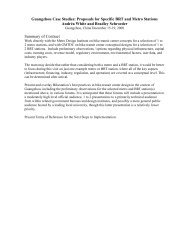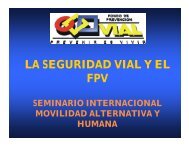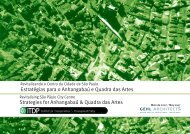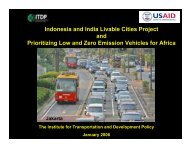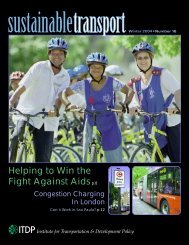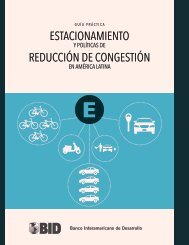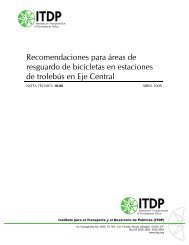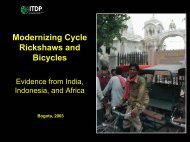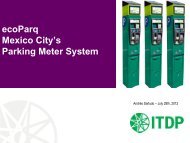Europe's Vibrant New Low Car(bon) Communities - ITDP | Institute ...
Europe's Vibrant New Low Car(bon) Communities - ITDP | Institute ...
Europe's Vibrant New Low Car(bon) Communities - ITDP | Institute ...
You also want an ePaper? Increase the reach of your titles
YUMPU automatically turns print PDFs into web optimized ePapers that Google loves.
Greenwich Millennium Village 17<br />
trips. Several more live/work units are planned as part of Phases<br />
3 and 4. Overall it was found that 7% of GMV residents work from<br />
home. This is similar to the proportion for Greenwich (7%) and<br />
slightly lower than for Inner London (9%), Outer London (9%),<br />
and London (9%) (Rutherfords 2005).<br />
The results of this analysis show that the policy and design<br />
measures applied in GMV appear to have had a strong influence on<br />
reducing car trips made by residents, however potential remains to<br />
increase cycling trips, particularly within the development.<br />
lessons learned<br />
While GMV residents drive less than their neighbors due to strong<br />
policy and design measures, overall car ownership remains higher<br />
than some of the other communities we reviewed. This is due in part<br />
to the location of GMV, far from central London, which demonstrates<br />
the importance of locating new development as close as possible to<br />
existing development.<br />
The good news is, GMV’s good public transit access, combined<br />
with the existence of London’s congestion fee, have resulted in an<br />
impressive commute mode share of 79% by public transit.<br />
Yet the travel choices of residents within the GMV development<br />
could still be improved. About half of residents travel by car for their<br />
weekly grocery shopping trip. Increasing the number and diversity<br />
of stores located at GMV could encourage more walking and cycling<br />
trips within the development as opposed to driving. Eight percent<br />
of residents already have groceries delivered; stores could further<br />
promote this service to encourage shoppers to leave their cars at<br />
home. It is important to ensure that these deliveries are made using<br />
sustainable transportation practices.<br />
GMV also provides live/work units. However, at the time of the<br />
survey in 2005, the presence of these units did not seem to increase<br />
the proportion of residents working from home above that of the<br />
surrounding area. Promotion of these units and addition of units in<br />
Phases 3 and 4 may encourage more residents to work from home.<br />
Home offices have the obvious benefit of reducing commute trips.<br />
However, some studies have shown an increase in other trips due to<br />
the increased flexibility of the work schedule. This is another reason<br />
why it is essential to provide amenities within walking distance of<br />
residences in order to encourage residents to walk and cycle for their<br />
daily needs rather than traveling outside the development by car to<br />
access goods and services.<br />
sources<br />
Birch, <strong>Car</strong>olyn (2010). Using Section 106<br />
Agreements to Improve Air Quality, <strong>Communities</strong><br />
and Local Government, London.<br />
Cherry, Alan and Hodkinson, Richard (2009).<br />
Millennium Homes Revisited, Ingenia, Issue 41,<br />
December 2009. http://www.ingenia.org.uk/<br />
ingenia/issues/issue41/Cherry_Hodkinson.pdf<br />
Communication with Kim Smith, Transportation<br />
Planning and Strategy Manager, Greenwich<br />
Council, May 4, 2010.<br />
Communication with Marcello Burbante,<br />
Greenwich Millennium Village Ltd. (GMVL),<br />
September 3, 2010.<br />
Coutryside Properties website, http://www.<br />
countryside-properties-corporate.com (accessed<br />
September 21, 2010).<br />
Department for <strong>Communities</strong> and Local Government<br />
(2004). Contributing to Sustainable<br />
<strong>Communities</strong> — A <strong>New</strong> Approach to Planning<br />
Obligations, Eland House, London.<br />
English Partnerships (2007). Millennium <strong>Communities</strong><br />
Programme, London. http://www.<br />
urbandesigncompendium.co.uk/public/documents/Mill%20Comms%20May%202007.pdf<br />
English Partnerships website, http://www.<br />
englishpartnerships.co.uk/gmv.htm (accessed<br />
June 28, 2010).<br />
GMV website, http://www.gmv.gb.com/transport.<br />
htm (accessed September 21, 2010).<br />
Rutherfords — Highway & Transport Planning<br />
(2005). Greenwich Millennium Village: Travel<br />
Monitoring Study, 2005 Report, Cambridge.<br />
Streetcar website, http://www.streetcar.<br />
co.uk/location.aspx?location=633 (accessed<br />
September 21, 2010).<br />
Transport for London (2008). Central London<br />
Congestion Charging: Impacts Monitoring —<br />
Sixth Annual Report, London.<br />
Transport for London (2009). Travel in London —<br />
Key Trends and Developments Report<br />
Number 1, London.<br />
Transport for London (2010). Travel in London:<br />
Report 2, London.<br />
Transport for London website, http://www.tfl.gov.<br />
uk/ (accessed September 21, 2010).<br />
Image credits<br />
Figure 1: http://maps.google.de/maps/ms?hl=en<br />
&ie=UTF8&vps=3&jsv=298d&oe=UTF8&msa=<br />
0&msid=116478322990710211544.000491ed99c<br />
ace2d3ecac<br />
Photo 1: Andrew Sparkes, www.pinholedesign.co.uk<br />
Photo 2: Nicole Foletta, <strong>ITDP</strong> Europe<br />
Photos 3, 4: Frederique Siegel, <strong>ITDP</strong> Europe





